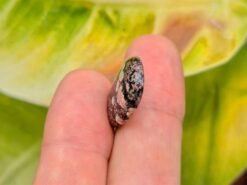Starry night obsidian

Starry night obsidian, also named Firecracker obsidian or flower obsidian.
An intriguing combination of black obsidian with splashes of coral, cream, pink and white snowflakes throughout.
Buy natural starry night obsidian in our shop
Obsidian volcanic glass
Obsidian is a naturally occurring volcanic glass formed as an extrusive igneous rock.
Obsidian is produced when felsic lava extruded from a volcano cools rapidly with minimal crystal growth. It is commonly found within the margins of rhyolitic lava flows known as obsidian flows, where the chemical composition: high silica content, causes a high viscosity, which, upon rapid cooling, results in a natural glass forming from the lava.
The inhibition of atomic diffusion through this highly viscous lava explains the lack of crystal growth. Obsidian is hard, brittle, and amorphous. It therefore fractures with sharp edges. In the past, it was used to manufacture cutting and piercing tools, and it has been used experimentally as surgical scalpel blades.
Starry night obsidian, from Mexico
Starry night obsidian properties
Obsidian is formed from quickly cooled lava, which is the parent material. Extrusive formation of obsidian may occur when felsic lava cools rapidly at the edges of a felsic lava flow or volcanic dome, or when lava cools during sudden contact with water or air. Intrusive formation of obsidian may occur when felsic lava cools along the edges of a dike.
Obsidian is mineral-like, but not a true mineral because as a glass it is not crystalline. In addition, its composition is too variable to be classified as a mineral. It is sometimes classified as a mineraloid. Though obsidian is usually dark in color, similar to mafic rocks such as basalt, obsidian’s composition is extremely felsic.
Obsidian consists mainly of silicon dioxide, usually 70% or more. Crystalline rocks with a similar composition include granite and rhyolite. Because obsidian is metastable at the Earth’s surface, over time the glass becomes fine-grained mineral crystals, no obsidian has been found that is older than the Cretaceous period.
This transformation of obsidian is accelerated by the presence of water. Although newly-formed obsidian has a low water content, typically less than 1% water by weight, it becomes progressively hydrated when exposed to groundwater, forming perlite.
Starry night obsidian under microscope
Natural starry night obsidian for sale in our shop
We make custom made starry night obsidian as engagement rings, necklaces, stud earrings, bracelets, pendants… Please contact us for a quote.
















